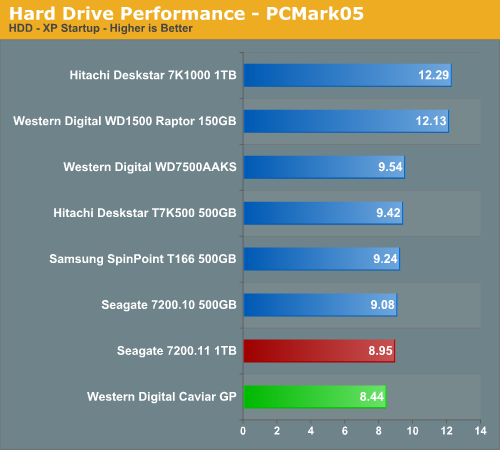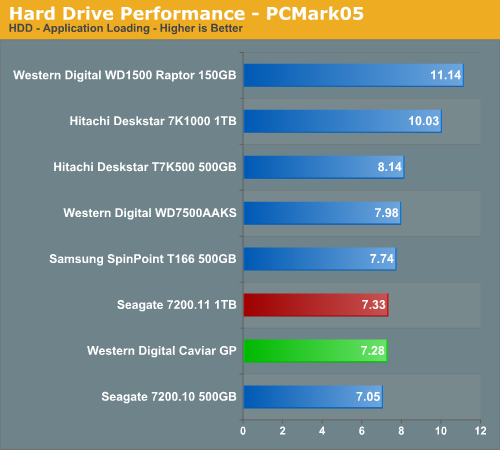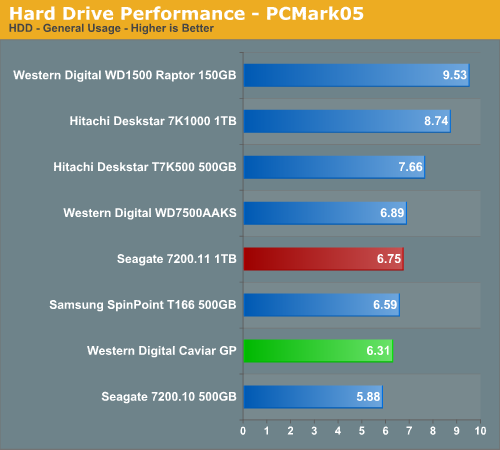Seagate and Western Digital 1TB Drives: Improved and Green
by Dave Robinet on November 26, 2007 7:00 AM EST- Posted in
- Storage
PCMark05
We use the HDD
test suite within PCMark05 for further comparative hard disk scores as it provides
a mixture of actual application results and specific read/write percentages made
use of by these programs. The program utilizes the RankDisk application within the
Intel iPEAK SPT suite of tools to record a trace of disk activity during usage of
real world applications. We replay these traces to generate performance measurements
based upon the actual disk operations within each application. The HDD test suite
contains 53% read and 47% write operations with each trace section utilizing varied
amounts of read or write operations.



In PCMark05, we see a substantial narrowing of the performance gap between the Seagate and the Western Digital drive, though neither device fares particularly well against the competition. The XP Startup portion of the test is particularly brutal on our 1TB drives, putting the 7200.11 behind the 7200.10 and just barely edging out the 7200.9 competition, which Seagate markets as being two generations older.
The Western Digital drive finishes at or near the bottom in every test. While this result is not surprising given WD's focus on power saving features rather than performance, it is certainly enough to give pause to the average desktop user who would consider choosing this unit for a heavy multitasking setup.










31 Comments
View All Comments
Luminair - Tuesday, November 27, 2007 - link
"Operating System Stated Capacity"Lets be clear so maybe you can be clear in the next article.
The IEC, IEEE, CPIM, and NIST define Giga (G) as 1,000,000,000 or one billion.
The same standards organizations define Gibi (Gi) as 1,073,741,824.
As such, by standard definitions, these hard drives are in fact 1000GB, or 1000 gigabytes.
Your "Operating System Stated Capacity" really means "Windows Explorer Capacity". Other operating systems don't get it wrong like Windows does. So if you report this wrong information at all, you should make the truth known -- that Windows is well known to WRONGLY report GiB as GB (and MiB for MB and so on).
Those drives have 1000 gigabytes of space. Windows Explorer and solid state memory companies report the space incorrectly.
Luminair - Friday, November 30, 2007 - link
These guys get it right :) http://www.pcgameshardware.de/?menu=browser&ar...">http://www.pcgameshardware.de/?menu=bro...&ima...valherumk2 - Tuesday, November 27, 2007 - link
Looks like another review of the 7200.11 drive where it appears the reviewer didn't remove the jumper limiting it to SATA 1. Interface bandwidth burst rate is over 200MB/s on my 7200.11 with the jumper removed.Zap - Thursday, November 29, 2007 - link
That's also the first thing that came to my mine... "dude forgot to remove the jumper."Zap - Thursday, November 29, 2007 - link
That's also the first thing that came to my mine... "dude forgot to remove the jumper."100proof - Monday, November 26, 2007 - link
Dave, is there a reason that Samsung's 1TB drivewas not included in this review? The drive is
difficult to obtain in the US but is available in
other countries at this point in time. Tomshardware
has already posted a review, and there is also
discussion taking place on storagereview.com
Tomshardware Review of Samsung F1 1TB
http://www.tomshardware.com/2007/11/21/samsung_ove...">http://www.tomshardware.com/2007/11/21/samsung_ove...
Storagereview discussion of F1 Series
http://forums.storagereview.net/index.php?showtopi...">http://forums.storagereview.net/index.php?showtopi...
Dave Robinet - Tuesday, November 27, 2007 - link
It's a matter of availability, not of lack of interest. We do like the latest Samsung offerings - they simply didn't have a drive shipped to us in the lab in time for the article.If they get us a 1TB drive for us to have a look at, then we'll gladly put it in a future article.
Thanks for reading!
quanta - Wednesday, November 28, 2007 - link
In the meantime, Tom's hardware did the Samsung Spinpoint F1 review[1], which showed it has great non-server performance. In fact, it outruns WD Raptor WD150ADFD in some tests. Power consumption is between 'cuda 7200.11 and Caviar GP.[1] http://www.tomshardware.com/2007/11/21/samsung_ove...">http://www.tomshardware.com/2007/11/21/samsung_ove...
piasabird - Monday, November 26, 2007 - link
You get a lower overall price per Gig by using two 500 gb drives.Googer - Monday, November 26, 2007 - link
With a pair of 500GB hard drives, you do not get it in a single volume, power consumption increases, RAID 0 decreases reliability and increases error possibilities.The fact that it takes two drive bays is a sore thumb to those who build small form factor multi-media systems with only one drive bay that will also funtion as a Digtal Video Recorder.
I should also add, this "GREEN" drive is ideal for a TiVO upgrade due to it's large size, quiet operation, low heat, and noise output.